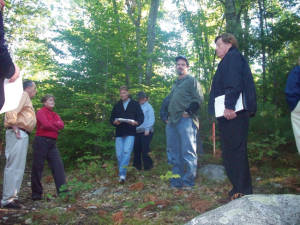Thoughts offered on cell tower
By Dawn De Busk
Staff Writer
CASCO — Bill Horton says a 150-foot cell tower in his backyard might devalue the view from the window of his log home, but that’s a minor thing

SITE TOUR — Property abutters William “Bill†Horton (left to right) and Terri Cosgrove listen to AT&T telecommunications consultant Robert Gashlin along with Planning Board member Lynne Potter, contracted town planning consultant Jim Seymour, and AT&T attorney Barry Hobbins. During Saturday’s site walk, a group of people hiked the trail up Spiller Hill to the proposed 50-foot by 50-foot spot AT&T hopes to clear for the construction of a new cell tower. (De Busk Photos)
compared to the noise of heating units and air conditioners ruining his peace and quiet.
And, he’s bothered by possible inconveniences like machinery blocking his road during the construction of an access road for AT&T’s proposed cell tower on Tamarack Trail.
Early Saturday morning, residents from the abutting property, members of the Casco Planning Board, Casco’s contracted town planner, representatives from AT&T, and other curious residents hiked through the woods to the site where the proposed mono-pole cell tower would be located. A large, red helium balloon was tethered to its rope spool in order to give people an idea of how the tower’s height of 150 feet would appear above the tree line. The telecommunications consultant hired by AT&T, Robert Gashlin, had showed up before the scheduled site walk to set up the balloon marker.
The area, which is referred to as 190 Tamarack Trail, is south of Route 11, west of Webb’s Mills Road (Route 85) and east of Coffee Pond. The spot is commonly known as Spiller Hill.
On Sept. 13, the Planning Board accepted the communication company’s application, and began its step-by-step site plan approval process. Nothing has been finalized yet.
Prior to addressing the agenda item on Monday, Chairman Horton recused himself. He will not vote on the Site Plan Approval nor will he sit at the board table during discussions. In fact, he is being represented by a lawyer.
At Saturday’s site walk, Horton was the abutting property owner. He hopes the unclear history of the subdivided lot will stall AT&T’s timeline for starting construction on the cell tower.
“It needs to be clear whether it’s a legal subdivision of record,†said David Fowler, the planning board member who will be acting chairman during this matter.
“There are a lot of questions here that need to be answered by our attorney. Those unanswered questions are regarding land division history,†Fowler said. The findings of the town attorney “will determine what the next step will be.â€
Another abutter, Terri Cosgrove had a quick list of concerns: Decreased property value, increased traffic, constant noise, and potential negative health issues stemming from radioactivity surrounding cell phone towers.
“I am worried about the impact to our health. There are studies coming out showing that the radioactivity from cell towers has caused health problems for people living near them,†Cosgrove said.
“Do we need these things every three miles everywhere? They are ruining people’s property,†she said.
Like Horton, Cosgrove thinks the tower base will disrupt the quietness of the woods. She and Horton toured some other cell tower sites recently. The noise from air conditioning and heating units and generators was bothersome, she said.
Among these fears of what could happen if a cell tower is built near her home, Cosgrove feels the presence of a 150-foot tower would taint her fantastic view, a more likely threat when the buffer of leaves disappears with winter.
AT&T’s paperwork revealed a ratio of 90 percent coniferous trees to 10 percent deciduous trees. Coniferous trees are those producing cones; and deciduous trees shed their leaves seasonally.
Cosgrove said, “I beg to differ. There are a lot more deciduous trees up there.â€
After a few moments at the site in the woods, Gashlin admitted he needed to swap those ratios because it was obvious 90 percent of the trees were large, leafy oaks and other deciduous species of New England trees while only 10 percent were evergreens.
A 50-foot by 50-foot space would need to be clear cut to accommodate the cell tower, according to Gashlin. The location is 600 feet from Horton’s property.
“We put some effort into minimizing the size,†said Gashline, adding that the tower will be located below the ridgeline.
“It won’t get much taller than this, folks,†said Jim Seymour, planning consultant hired by the Town of Casco. Nor will the structure get any bulkier, he said.
The proposed mono-pole tower will be able to only accommodate two more co-locators. Meanwhile, the tower on Hackers Hill is 150-feet tall, but it has much more equipment on it than the proposed mono-pole tower is designed to handle.
During the Sept. 13 meeting, Acting Chairman Fowler had suggested AT&T allow the Public Safety Department to put its communication equipment on the tower lease-free. Attorney Barry Hobbins said that was doable, but the equipment cost would be the town’s financial burden.
“This would be a benefit to the community,†Fowler said.
On Saturday morning, many people had driven their vehicles up the hill to see if they could glimpse the floating red balloon from the yards of the Gosgroves’ home or Horton’s cabin. Other people said they planned to check it out from Pine Ridge. The owner of Webbs Mills Variety said he hadn’t seen the balloon from his place of business; and he “showed up to listen†during the site walk.
“I went up Hackers Hill; and I couldn’t see the balloon from there,†Fowler said. “There’s no question the location is about as good a location, the least obtrusive†AT&T could find for its cell phone coverage needs.

